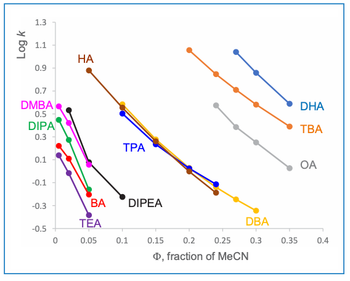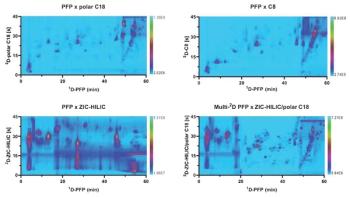Key Points
- Metabolomics has recently played a major role in cancer research, being used to study cancer metabolism and to identify patterns among metabolites for use as biomarkers.
- The researchers developed a novel UHPLC–MS/MS method for quantifying bile acids and tryptophan metabolites in human serum samples.
- Salting-out assisted liquid-liquid extraction (SALLE) was applied for the analysis of thyroxine (T4) and steroid hormones in serum.
- The new UHPLC–MS/MS method showed strength in possibly being implementable alongside other high-throughput clinical assays, though there is room for improvement.
Researchers from Stavanger University Hospital in Stavanger, Norway led efforts to develop a new method for determining tryptophan metabolites in human serum samples. Their findings were published in the Journal of Chromatography B (1).
Metabolomics is the large-scale study of metabolomes, often being conducted using gas chromatography or liquid chromatography coupled with mass spectrometry (GC–MS or LC-MS). In recent years, metabolomics has played a major role in cancer research, being used to study cancer metabolism and to identify patterns among metabolites for use as biomarkers. Global metabolomics, which is used to comprehensively determine wide ranges of metabolites, typically uses liquid chromatography coupled with high resolution mass spectrometry (LC-HRMS). This process produces large amounts of data, since it acquires symbols for nearly all metabolites that elute from LC columns. While useful for biomarker discovery, very few of the detected signals are properly assigned to known metabolites.
In this study, the researchers developed a novel method for quantifying bile acids and tryptophan metabolites in human serum samples using ultrahigh-performance liquid chromatography coupled with tandem mass spectrometry (UHPLC–MS/MS). Salting-out assisted liquid-liquid extraction (SALLE) was applied for the analysis of thyroxine (T4) and steroid hormones in serum. SALLE involves a homogeneous liquid-liquid extraction based on the addition of salts to the sample in the presence of a water-miscible organic solvent resulting in a phase separation from the initial aqueous solution (2). This technique can provide several advantages over classic LLE; for example, SALLE enables LLE to be performed with a polar and water miscible solvent, such as ACN, where phase separation occurs by adding salt. According to the scientists, SALLE can be used to extract polar tryptophan (TRP) metabolites together with non-polar BA from human serum, when trifluoroacetic acid (TFA) is added as an ion-pairing reagent. The method was also validated and applied to investigate serum levels of BA and TRP metabolites in healthy probands.
Robot pipetting and SALLE extraction could enable the use of a single microplate–without additional solvent transfer and evaporation–for both sample preparation and direct injection in the UHPLC–MS/MS system. The new method was adopted to the types of UHPLC column and mobile phases already present at the researchers’ hospital laboratory, which were implemented for routine analyses. A 50 mm short C18 reversed phase UPLC column and a mobile phase consisting of 0.2 % FA mixed with ACN were used. The short cycle time between injections (4 min and 32 s) made it possible to analyze a full 96 well microplate in about 7 h and 15 min. The new UHPLC–MS/MS method showed strength in possibly being implementable alongside other high-throughput clinical assays.
However, there was room for improvement. Other UHPLC–MS/MS methods could be used to detect 41 bile acids (BAs) in plasma, while the method in this experiment was only able to detect 8 (though the method in this study did prove to be significantly faster) (3). Nevertheless, the method did prove useful, serving as a foundation for future research towards exploring metabolic biomarkers in patients with specific diseases, including cancer.
References
(1) Oanes, C.; Alexeeva, M.; Søreide, K.; Brede, C. Salting-Out Assisted Liquid-Liquid Extraction for UPLC-MS/MS Determination of Bile Acids and Kynurenine-, Indole- and Serotonin-Pathway Metabolites of Tryptophan in Human Serum of Healthy Probands. J. Chromatogr. B 2025, 1255, 124519. DOI: 10.1016/j.jchromb.2025.124519
(2) Yao, J. S. T.; Ladner, Y.; Amin, N.’C C.; Perrin, C. Salting-Out Assisted Liquid-Liquid Extraction (SALLE): Principle, Optimization, and Applications in Blood Sample Analysis. J. Pharm. Biomed. Anal. 2025, 257, 116720. DOI: 10.1016/j.jpba.2025.116720
(3) Wang, Z.; Li, H.; Yun, Y.; et al. A Dynamic Multiple Reaction Monitoring Strategy to Develop and Optimize Targeted Metabolomics Methods: Analyzing Bile Acids in Capecitabine-Induced Diarrhea. J. Pharm. Biomed. Anal. 2022, 219, 114938. DOI: 10.1016/j.jpba.2022.114938





